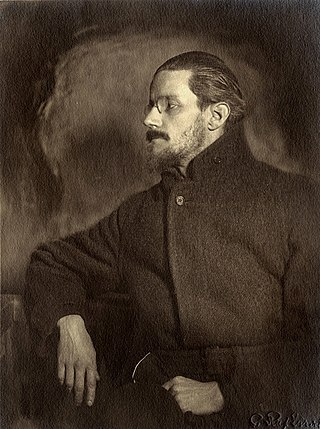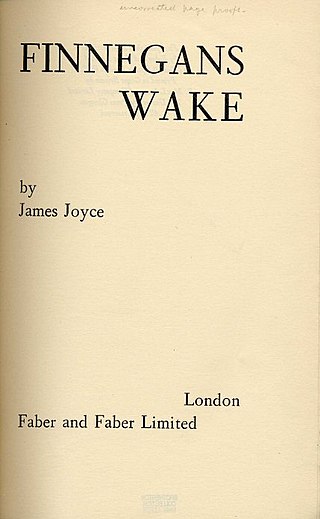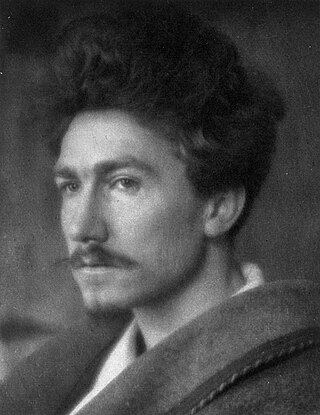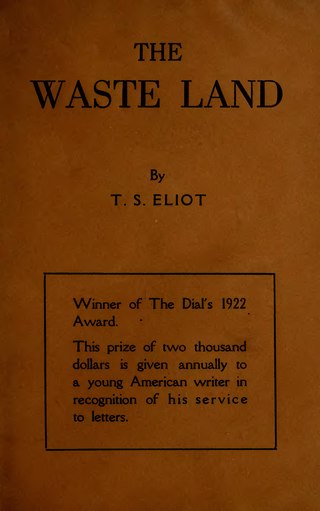
James Augustine Aloysius Joyce was an Irish novelist, poet, and literary critic. He contributed to the modernist avant-garde movement and is regarded as one of the most influential and important writers of the 20th century. Joyce's novel Ulysses (1922) is a landmark in which the episodes of Homer's Odyssey are paralleled in a variety of literary styles, particularly stream of consciousness. Other well-known works are the short-story collection Dubliners (1914), and the novels A Portrait of the Artist as a Young Man (1916) and Finnegans Wake (1939). His other writings include three books of poetry, a play, letters, and occasional journalism.

Ulysses is a modernist novel by Irish writer James Joyce. Parts of it were first serialized in the American journal The Little Review from March 1918 to December 1920, and the entire work was published in Paris by Sylvia Beach on 2 February 1922, Joyce's fortieth birthday. It is considered one of the most important works of modernist literature and has been called "a demonstration and summation of the entire movement." According to Declan Kiberd, "Before Joyce, no writer of fiction had so foregrounded the process of thinking."

Finnegans Wake is a novel by Irish writer James Joyce. It is well known for its experimental style and its reputation as one of the most difficult works of fiction in the Western canon. Written over a period of seventeen years and published in 1939, the novel was Joyce's final work. It is written in a largely idiosyncratic language which blends standard English with neologisms, portmanteau words, Irish mannerisms and puns in multiple languages to create a refracted effect. It has been categorized as "a work of fiction which combines a body of fables [...] with the work of analysis and deconstruction"; many critics believe the technique was Joyce's attempt to recreate the experience of dreams and hypnagogia, reproducing the way in which concepts, memories, people and places become amalgamated in dreaming. It has also been regarded as an attempt by Joyce to combine many of his prior aesthetic ideas, with references to other works and outside ideas woven into the text; Joyce declared that "every syllable can be justified". Due to its linguistic experiments, stream of consciousness writing style, literary allusions, free dream associations, and abandonment of narrative conventions, Finnegans Wake has been agreed to be a work largely unread by the general public.

Imagism was a movement in early-20th-century Anglo-American poetry that favored precision of imagery and clear, sharp language. It is considered to be the first organized modernist literary movement in the English language. Imagism is sometimes viewed as "a succession of creative moments" rather than a continuous or sustained period of development. The French academic René Taupin remarked that "it is more accurate to consider Imagism not as a doctrine, nor even as a poetic school, but as the association of a few poets who were for a certain time in agreement on a small number of important principles".

Leopold Bloom is the fictional protagonist and hero of James Joyce's 1922 novel Ulysses. His peregrinations and encounters in Dublin on 16 June 1904 mirror, on a more mundane and intimate scale, those of Ulysses/Odysseus in Homer's epic poem: The Odyssey.

Umberto Saba was an Italian poet and novelist, born Umberto Poli in the cosmopolitan Mediterranean port of Trieste when it was the fourth largest city of the Austro-Hungarian Empire. Poli assumed the pen name "Saba" in 1910, and his name was officially changed to Umberto Saba in 1928. From 1919 he was the proprietor of an antiquarian bookshop in Trieste. He suffered from depression for all of his adult life.
In book publishing, an anthology is a collection of literary works chosen by the compiler; it may be a collection of plays, poems, short stories, songs or excerpts by different authors.

Dubliners is a collection of fifteen short stories by James Joyce, first published in 1914. It presents a naturalistic depiction of Irish middle class life in and around Dublin in the early years of the 20th century.
"The Song of the Cheerful Jesus" is a poem by Oliver St. John Gogarty. It was written around Christmas of 1904 and was later published in modified form as "The Ballad of Joking Jesus" in James Joyce's Ulysses.

Molly Bloom is a fictional character in the 1922 novel Ulysses by James Joyce. The wife of main character Leopold Bloom, she roughly corresponds to Penelope in the Odyssey. The major difference between Molly and Penelope is that while Penelope is eternally faithful, Molly is not. Molly is having an affair with Hugh 'Blazes' Boylan. Molly, whose given name is Marion, was born in Gibraltar on 8 September 1870, the daughter of Major Tweedy, an Irish military officer, and Lunita Laredo, a Gibraltarian of Spanish descent. Molly and Leopold were married on 8 October 1888. She is the mother of Milly Bloom, who, at the age of 15, has left home to study photography. She is also the mother of Rudy Bloom, who died at the age of 11 days. In Dublin, Molly is an opera singer of some renown.

Richard David Ellmann, FBA was an American literary critic and biographer of the Irish writers James Joyce, Oscar Wilde, and William Butler Yeats. He won the U.S. National Book Award for Nonfiction for James Joyce (1959), which is one of the most acclaimed literary biographies of the 20th century. Its 1982 revised edition was similarly recognised with the award of the James Tait Black Memorial Prize. Ellmann was a liberal humanist, and his academic work focused on the major modernist writers of the twentieth century.
Declan Kiberd is an Irish writer and scholar with an interest in modern Irish literature, both in the English and Irish languages, which he often approaches through the lens of postcolonial theory. He is also interested in the academic study of children's literature. He serves on the advisory board of the International Review of Irish Culture and is a professor at the University of Notre Dame and at its campus in Dublin. In recent years and with publications such as After Ireland (2018), Kiberd has become a commentator on contemporary Irish social and political issues, particularly as such issues have been examined by Ireland's writers.
"Two Lovers and a Beachcomber by the Real Sea" is a poem written by Sylvia Plath that was first published in 1955, the year she graduated from Smith College summa cum laude. An abstract poem about an absent lover, it uses clear, vivid language to describe seaside scenery, with "a grim insistence" on reality rather than romance and imagination.

Pomes Penyeach is a collection of thirteen short poems written by James Joyce.

Chamber Music is a collection of poems by James Joyce, published by Elkin Mathews in May 1907. The collection originally comprised thirty-four love poems, but two further poems were added before publication.
United States v. One Book Called Ulysses, 5 F. Supp. 182, is a landmark decision by the United States District Court for the Southern District of New York in a case dealing with freedom of expression. At issue was whether James Joyce's 1922 novel Ulysses was obscene. In deciding it was not, Judge John M. Woolsey opened the door to importation and publication of serious works of literature that used coarse language or involved sexual subjects.

The Waste Land is a poem by T. S. Eliot, widely regarded as one of the most important poems of the 20th century and a central work of modernist poetry. Published in 1922, the 434-line poem first appeared in the United Kingdom in the October issue of Eliot's The Criterion and in the United States in the November issue of The Dial. It was published in book form in December 1922. Among its famous phrases are "April is the cruelest month", "I will show you fear in a handful of dust", "These fragments I have shored against my ruins" and the Sanskrit mantra "Shantih shantih shantih".

Paul Wunderlich was a German painter, sculptor and graphic artist. He designed Surrealist paintings and erotic sculptures. He often created paintings which referred to mythological legends.
Amalia Popper was the first Italian translator of James Joyce's works and author of his first biography, published as an introduction to his translation of Dubliners, published in 1935 in Trieste under the title "Araby".
Niall Sheridan (1912–1998) was an Irish poet, fiction-writer, and broadcaster, remembered primarily for his friendships with better-known Irish writers Brian O'Nolan and Donagh MacDonagh.













